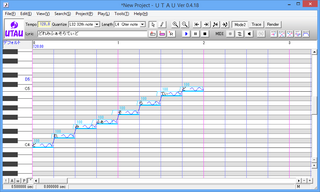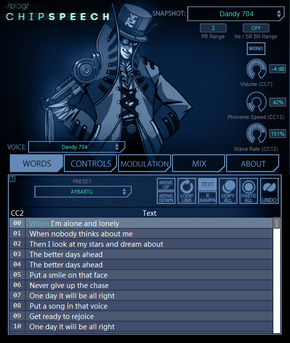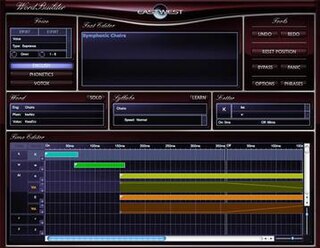 PPG Phonem interface | |
| Developer(s) | Wolfgang Palm |
|---|---|
| Initial release | 2015 |
| Available in | English, German and French |
| Type | Voice synthesizer |
| License | Proprietary |
| Website | www |
PPG Phonem is a vocal synthesizer VST/AU plugin.
 PPG Phonem interface | |
| Developer(s) | Wolfgang Palm |
|---|---|
| Initial release | 2015 |
| Available in | English, German and French |
| Type | Voice synthesizer |
| License | Proprietary |
| Website | www |
PPG Phonem is a vocal synthesizer VST/AU plugin.
PPG Phonem was originally designed to do just vocal synthesis, though it is capable of acting as a universal sound synthesizer. It has 12 individual resonators which all impact the sound output .It organizes sound at the level of the individual phoneme and strings phonemes together, every phoneme within can be adjusted to alter the result. As a result, it is possible to create the phonetic sounds for any language, though is limited by the users knowledge of the phonemes required. It comes ready capable of creating American English, German and French using a simple dictionary and has 2 females and 4 male vocals plus synthetic textures. The software is capable of producing a range of human noises such as whispering or roaring or create inhuman sounds such as bass plucks. [1] [2]
Bedroom Producers Blog reviewer "D Smolken" rates Phonem "Brilliant", giving 5 stars for performance, 4.5 stars for features, design, sound and price, and 4 stars for workflow. The review stated that Phonem "provide(s) an enormous amount of control over every detail of the sound and the flexibility to whisper, speak, sing, growl, roar, and even make sounds which are not human at all, but very reminiscent of classic synthesizers", "puts a serious amount of power at your fingertips, even by the standards of non-vocal synthesizers. While other vocal synthesizers make it seem like you’re telling a robot what to sing and how, Phonem feels more like you’re inside the robot controlling every detail of what its robotic vocal tract does. It’s very scientific, in a mad scientist way", and "Phonem is very powerful and provides a level of control that no other vocal synthesizer does." D SMOLKEN noted in their final verdict noted that "Phonem is best at synthesizing abstract weirdness" and concluded that the synthesizer was a powerful tool with editing at a level that no other synthesizer offered. [1]
Speech synthesis is the artificial production of human speech. A computer system used for this purpose is called a speech synthesizer, and can be implemented in software or hardware products. A text-to-speech (TTS) system converts normal language text into speech; other systems render symbolic linguistic representations like phonetic transcriptions into speech. The reverse process is speech recognition.
The Culture is a fictional interstellar post-scarcity civilisation or society created by the Scottish writer Iain M. Banks and features in a number of his space opera novels and works of short fiction, collectively called the Culture series.

Singing is the act of creating musical sounds with the voice. A person whose profession is singing is called a singer, artist or vocalist. Singers perform music that can be sung with or without accompaniment by musical instruments. Singing is often done in an ensemble of musicians, such as a choir. Singers may perform as soloists or accompanied by anything from a single instrument up to a symphony orchestra or big band. Different singing styles include art music such as opera and Chinese opera, Indian music, Greek music, Japanese music, and religious music styles such as gospel, traditional music styles, world music, jazz, blues, ghazal, and popular music styles such as pop, rock, and electronic dance music.

Multitrack recording (MTR), also known as multitracking, is a method of sound recording developed in 1955 that allows for the separate recording of multiple sound sources or of sound sources recorded at different times to create a cohesive whole. Multitracking became possible in the mid-1950s when the idea of simultaneously recording different audio channels to separate discrete "tracks" on the same reel-to-reel tape was developed. A "track" was simply a different channel recorded to its own discrete area on the tape whereby their relative sequence of recorded events would be preserved, and playback would be simultaneous or synchronized.

An instrument amplifier is an electronic device that converts the often barely audible or purely electronic signal of a musical instrument into a larger electronic signal to feed to a loudspeaker. An instrument amplifier is used with musical instruments such as an electric guitar, an electric bass, electric organ, electric piano, synthesizers and drum machine to convert the signal from the pickup or other sound source into an electronic signal that has enough power, due to being routed through a power amplifier, capable of driving one or more loudspeaker that can be heard by the performers and audience.

Beatboxing is a form of vocal percussion primarily involving the art of mimicking drum machines, using one's mouth, lips, tongue, and voice. It may also involve vocal imitation of turntablism, and other musical instruments. Beatboxing today is connected with hip-hop culture, often referred to as "the fifth element" of hip-hop, although it is not limited to hip-hop music. The term "beatboxing" is sometimes used to refer to vocal percussion in general.
Domo is an experimental robot made by the Massachusetts Institute of Technology designed to interact with humans. The brainchild of Jeff Weber and Aaron Edsinger, cofounders of Meka Robotics, its name comes from the Japanese phrase for "thank you very much", domo arigato, as well as the Styx song, "Mr. Roboto". The Domo project was originally funded by NASA, and has now been joined by Toyota in funding robot's development.

Generator Gawl is a 1998 12-episode anime television series produced by Tatsunoko Productions and the Victor Company of Japan. The story is set in 2007, when Professor Takuma Nekasa uncovers a gene code that will unlock the human body's greatest mystery and expose mankind to its greatest threat. As a result, Gawl, Koji, and Ryo—three young scientists from a future period—have traveled back in time to undo this mistake. Though the trio intended to arrive one year before the calamity, they are instead transported three months prior to the event. In their effort to save the world, they are opposed by the mysterious and cunning Ryuko Saito, a scientist who prefers the future as it is. Saito is assisted by Generators, unearthly assassins posing as humans. As Ryo and Koji try to complete their mission, Gawl himself must "generate"—becoming like his enemies to fight on their terms.

Auto-Tune is an audio processor introduced in 1997 by the American company Antares Audio Technologies. It uses a proprietary device to measure and alter pitch in vocal and instrumental music recording and performances.
The Coldfire Trilogy is a science fiction/fantasy trilogy written by Celia S. Friedman. It includes:

Palm Products GmbH was a manufacturer of audio synthesizers. Founded and owned by Wolfgang Palm, PPG was located in Hamburg, Germany and, for 12 years from around 1975 to 1987, manufactured an acclaimed and eclectic range of electronic musical instruments, all designed by Palm.

Vocal pedagogy is the study of the art and science of voice instruction. It is used in the teaching of singing and assists in defining what singing is, how singing works, and how proper singing technique is accomplished.

The HRP-4C, nicknamed Miim, is a feminine-looking humanoid robot created by the National Institute of Advanced Industrial Science and Technology (AIST), a Japanese research facility.

The PPG Wave is a series of synthesizers built by the German company Palm Products GmbH from 1981 to 1987.

UTAU is a Japanese singing synthesizer application created by Ameya/Ayame (飴屋/菖蒲). This program is similar to the VOCALOID software, with the difference being it is shareware instead of under a third party licensing.
A mixing engineer is responsible for combining ("mixing") different sonic elements of an auditory piece into a complete rendition, whether in music, film, or any other content of auditory nature. The finished piece, recorded or live, must achieve a good balance of properties, such as volume, pan positioning, and other effects, while resolving any arising frequency conflicts from various sound sources. These sound sources can comprise the different musical instruments or vocals in a band or orchestra, dialogue or foley in a film, and more.

Cantor was a vocal singing synthesizer software released four months after the original release of Vocaloid by the company VirSyn, and was based on the same idea of synthesizing the human voice. VirSyn released English and German versions of this software. Cantor 2 boasted a variety of voices from near-realistic sounding ones to highly expressive vocals and robotic voices.

Chipspeech is a vocal synthesizer software which was created by Plogue with the goal of recreating 1980s synthesizers.

Alter/Ego (アルター・エゴ) is a free real-time vocal synthesizer software which was created by Plogue.

Symphonic Choirs is a vocal synthesizer and vocal library software created by EastWest, designed to imitate an entire vocal choir. The content was created by producers Doug Rogers and Nick Phoenix with recording engineer Keith O. Johnson for EastWest. Recorded in a real concert hall, the software initially had two styles of producing a result, the first being the "PLAY" engine version and the second being the "WordBuilder". The WordBuilder works by the user typing in what they want the software to recreate and it playing back the words.